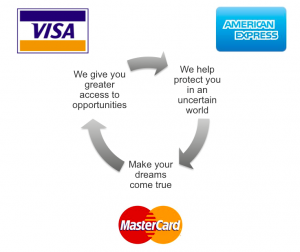Whether we call it a “competitive simulation,” a “brand duel,” or even a “strategic chess match,” nothing sums up the no-holds barred branding exercise better than the term “War Games.” Yes, I said branding exercise. While it appears to be merely a marketing exercise aimed at developing future-proof strategies and tactics for a product/service entering the arena or defending it from new powers, it should be the cultivation of your brand in action. Brands are more about what they stand for than how they behave. So let’s examine the practice of War Gaming as it relates to brand development.
First, let’s set expectations of what I mean by the term. War Games is traditionally the act of studying what competitors would do if your brand makes a certain move in the market, and then what counter-strategies your brand would make. It can be done if your brand is entering a market with established competition, or conversely, if your brand is on the market and new competitors are entering.  War Games are most often conducted in a workshop setting where the moves/countermoves are played out. Representatives from the client team role-play competitive brands and determine things like marketing strategies, tactics and budget allocation. Then they swap sides and to the same for their own brand.
War Games are most often conducted in a workshop setting where the moves/countermoves are played out. Representatives from the client team role-play competitive brands and determine things like marketing strategies, tactics and budget allocation. Then they swap sides and to the same for their own brand.
What they don’t do is examine the exercise from a branding point of view. In their landmark treatise, Positioning: the battle for your mind, authors Reis and Trout coined the metaphor that led to the concept of competitiveness as a war. But they looked at the process not as a war fought out in the marketplace, but rather the war that occurs inside the minds of customers about how brands adhere—or not—to the customer’s own identity. It is important to examine competitive marketing strategies, but such an activity shouldn’t be done at the expense of how brands compete psychologically.
All the tactics in the world won’t matter if they are not in line with the behaviors inspired by a branding strategy: the brand promise made to customers, and the brand personality (the tone and attitude with which the promise gets delivered). Any brand can change its messaging or field a website or spend money trying to outflank the competition. However, such actions are short-lived if they are not done in the context of long-term brand development.
Take the example of Advil vs. Nuprin back in the 1980s. Both contained the exact same ingredient (ibuprofen); both were launched by marketing powerhouses (American Home Products and Bristol Meyers Squibb respectively); and both had the same budgets. For all intents and purposes, they were exactly the same. The attack and counter attacks played out in the market were secondary to the brand building going on in the minds of customers. 
 Nuprin stood for a new, trendy way to treat daily aches and pains, while Advil stood for an evolution of scientific advances in the treatment of pain. One was playful while the other was clinical. And all the market moves—advertising, packaging, TV and radio—didn’t put them in a war of equals. Rather it guaranteed victory for Advil precisely because the Advil brand identity—its promise and personality—better engaged the values that customers had about their own pain. Pain is serious. And one treats a serious condition with medicine, not a playfully positioned brand that mimics the way many consumer goods are positioned. Advil made $500 million in its first year; Nuprin earned $50,000. And no amount of war-gaming the marketing and tactics would have made a difference.
Nuprin stood for a new, trendy way to treat daily aches and pains, while Advil stood for an evolution of scientific advances in the treatment of pain. One was playful while the other was clinical. And all the market moves—advertising, packaging, TV and radio—didn’t put them in a war of equals. Rather it guaranteed victory for Advil precisely because the Advil brand identity—its promise and personality—better engaged the values that customers had about their own pain. Pain is serious. And one treats a serious condition with medicine, not a playfully positioned brand that mimics the way many consumer goods are positioned. Advil made $500 million in its first year; Nuprin earned $50,000. And no amount of war-gaming the marketing and tactics would have made a difference.
So when conducting war games, the focus should start with the brands’ identities. What do the competitive brands stand for in the minds of customers? What do customers buy when they buy your brand: some functional aspect like price or quality, or more practical and emotional benefits? When people buy a Mercedes they don’t buy a well-engineered car; they buy status. When people buy Home Depot, they don’t buy hammers and saws and lumber; they buy self-empowerment. The first step of a war game, therefore, should be to establish what business the competitors are in.
Take the virtually identical services sold by Visa, American Express and Mastercard and strip away any additional branding imparted by banks or airlines. Visa takes a functional benefit—accepted in more places worldwide—and turns it into the opportunity business (Everywhere you want to be).  American Express seizes on a practical benefit—the world of commerce is threatening at times—and turns it into the protection business (Don’t leave home without it). And Mastercard is built on an emotional benefit—people aspire to making their dreams come true—and turns it into the fulfillment business (Priceless!). You can war-game all the marketing strategies and tactics in the world and win a momentary battle here and there. However, a war game based on brand identity will win the war in the long term.
American Express seizes on a practical benefit—the world of commerce is threatening at times—and turns it into the protection business (Don’t leave home without it). And Mastercard is built on an emotional benefit—people aspire to making their dreams come true—and turns it into the fulfillment business (Priceless!). You can war-game all the marketing strategies and tactics in the world and win a momentary battle here and there. However, a war game based on brand identity will win the war in the long term.
So remember, to win at war-gaming, don’t be the general pushing pieces around on a board. Be the flag under which all your efforts march. People fight for causes, not territory. And in fighting for a cause, your brand secures a place in the hearts and minds of those who loyally follow you no matter what tactics try to stop them.

Excellent contents, love your blogs!